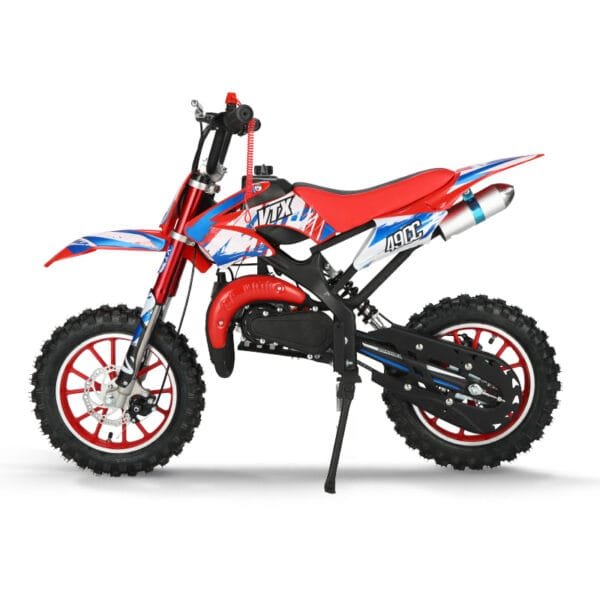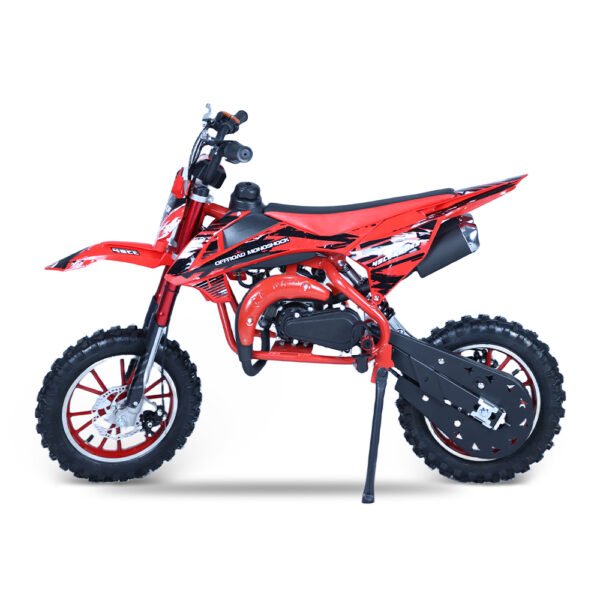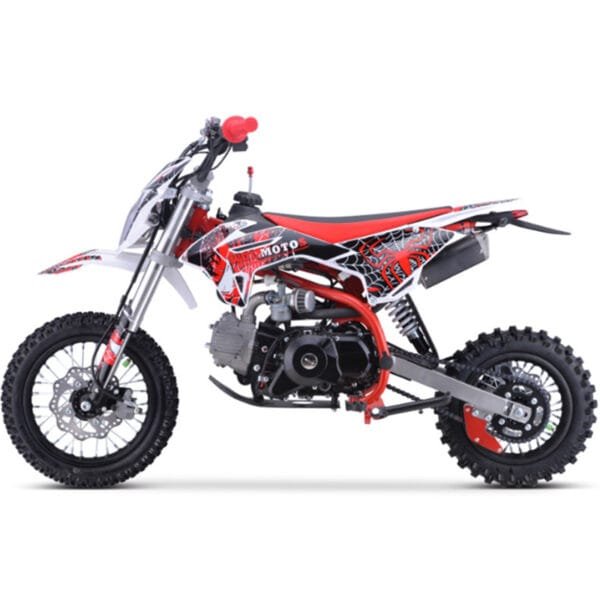
Dirt Bikes: What They Are and How They Work
Dirt Bikes: What They Are and How They Work
Introduction to Dirt Bikes
What is a Dirt Bike?
Dirt bikes are lightweight, off-road motorcycles designed specifically for navigating rugged terrains and unpaved trails.
Unlike traditional street motorcycles, dirt bikes have features that enhance their performance on dirt, mud, sand, and rocky surfaces.
They are built for agility, offering high suspension and knobby tires that provide excellent grip and control.
Riders often use dirt bikes for recreational purposes, competitions, or even as a means of transportation in less accessible areas.
Brief History of Dirt Bikes
The concept of dirt bikes can be traced back to the early 20th century, with the first motorcycles adapted for off-road use appearing in the 1930s.
Over the decades, dirt biking evolved from simple, rugged machines to highly specialized vehicles, leading to the establishment of motocross as a formal sport in the 1960s.
This evolution sparked innovations in design and technology, making dirt bikes faster, lighter, and more durable.
Types of Dirt Bikes
Motocross Bikes
Motocross bikes are engineered for competitive racing on closed circuits.
They typically have powerful engines and advanced suspension systems to handle jumps and rough terrain.
These bikes prioritize speed and agility, making them a favorite among serious racers.
Trail Bikes
Trail bikes are versatile machines ideal for beginners and casual riders.
They are designed for slower speeds and are often more comfortable to ride over long distances.
With a focus on stability and ease of use, trail bikes are perfect for exploring wooded areas and mild terrains.
Enduro Bikes
Enduro bikes bridge the gap between motocross and trail bikes, designed for both racing and recreational use.
They feature durable construction and are equipped to handle various terrains, including steep hills and rough trails.
Enduro racing involves long-distance events with varying conditions, testing both the bike and rider endurance.
Dual-Sport Bikes
Dual-sport bikes are street-legal motorcycles that can perform well both on and off the road.
They blend features of dirt bikes and traditional motorcycles, offering versatility for riders who want to navigate city streets and dirt trails.
These bikes usually have a more comfortable seating position and better fuel efficiency.
Key Components of Dirt Bikes
Engine Types
Dirt bikes typically feature two-stroke or four-stroke engines.
Two-stroke engines are lighter and provide higher power-to-weight ratios, making them ideal for racing.
Four-stroke engines, on the other hand, are known for their durability and fuel efficiency, making them suitable for trail riding.
Suspension Systems
The suspension is crucial for absorbing shocks from rough terrain.
Most dirt bikes have long-travel suspensions, allowing for better handling and comfort.
The two main types of suspension systems are telescopic forks at the front and monoshock or dual-shock setups at the rear, each designed to enhance the bike’s stability and control.
Tires and Wheels
Dirt bike tires are specially designed with deep treads to provide traction on loose surfaces.
The wheel size can vary, with smaller wheels generally providing better control and stability, while larger wheels can handle obstacles more effectively.
Choosing the right tires is essential for optimizing performance in different riding conditions.
Frame Materials
The frame of a dirt bike is typically made from lightweight materials like aluminum or steel.
The choice of material affects the bike’s overall weight, durability, and handling characteristics.
A well-constructed frame ensures that the bike can withstand the rigors of off-road riding.
How Dirt Bikes Work
The Engine Mechanism
Understanding how a dirt bike’s engine works is key to appreciating its performance.
The engine converts fuel into energy through combustion, which drives the pistons and turns the crankshaft.
In two-stroke engines, this process is simplified, resulting in quicker power delivery, while four-stroke engines go through a more complex cycle, providing smoother power over time.
Transmission and Gearing
Dirt bikes typically feature a manual transmission with multiple gears, allowing riders to adjust power delivery based on terrain and riding conditions.
Gear ratios are designed to optimize performance, with lower gears providing better torque for climbing hills and higher gears suitable for flat surfaces and speed.
Suspension Functionality
The suspension system absorbs shocks and impacts, ensuring a smoother ride.
It also helps maintain tire contact with the ground, which is crucial for control and stability.
Riders can adjust suspension settings based on their weight and riding style, allowing for a personalized experience on different terrains.
Safety Features in Dirt Bikes
Protective Gear
Safety is paramount in dirt biking.
Riders are encouraged to wear protective gear, including helmets, gloves, goggles, and padded clothing.
This gear is designed to absorb impacts and protect against abrasions during falls.
Investing in high-quality protective equipment can significantly reduce the risk of injury.
Bike Safety Features
Modern dirt bikes come equipped with various safety features, such as improved braking systems, skid plates, and reinforced frames.
Some bikes also include features like kill switches and LED lights, enhancing safety during rides, especially in low-visibility conditions.
Importance of Safety Training
Before hitting the trails, it’s crucial for riders, especially beginners, to undergo proper training.
Safety courses teach essential riding techniques, bike handling, and how to respond to emergencies.
Many organizations offer certified training programs that help instill good riding habits and improve overall safety.
Choosing the Right Dirt Bike
Factors to Consider
When selecting a dirt bike, several factors come into play.
First, you need to assess your skill level.
Beginners should consider bikes with lower power outputs and manageable weights, while experienced riders might look for models with higher performance capabilities.
Additionally, the type of riding you plan to do—whether it’s racing, trail riding, or a mix—will significantly influence your choice.
Size and Weight
The size and weight of a dirt bike are crucial for rider comfort and control.
A bike that’s too heavy can be difficult to maneuver, especially for newer riders.
It’s essential to find a bike that allows you to maintain a flat foot position when stopped, ensuring stability.
Also, consider the seat height; many manufacturers offer different models with various seat heights to accommodate riders of all sizes.
Engine Displacement
Engine displacement is a key factor in a dirt bike’s performance.
Measured in cubic centimeters (cc), a bike with a larger engine generally offers more power.
For beginners, 125cc to 250cc engines are often recommended.
Intermediate and advanced riders may prefer engines in the 250cc to 450cc range, depending on their riding style and preference.
Maintenance of Dirt Bikes
Regular Maintenance Checklist
Maintaining a dirt bike is essential for its longevity and performance.
Regular checks should include inspecting the oil level, checking tire pressure, and ensuring that the brakes are functioning correctly.
Cleaning the air filter is also critical, as dirt and debris can significantly affect engine performance.
A general rule is to perform these checks before and after each ride.
Common Repairs
Understanding common repairs can save you time and money.
Issues such as flat tires, chain wear, and brake pad replacements are typical for dirt bike riders.
Learning to perform basic repairs can enhance your riding experience and keep you on the trails longer.
Online tutorials and local mechanics can provide guidance on tackling these common problems.
Seasonal Maintenance Tips
As seasons change, so do the maintenance needs of your dirt bike.
Before winter, consider winterizing your bike by changing the oil and storing it in a dry place.
During the riding season, be vigilant about checking for wear and tear, especially after riding in harsh conditions.
Regularly clean and lubricate the chain to prevent rust and ensure smooth operation.
Dirt Bike Riding Techniques
Basic Riding Techniques
Mastering basic riding techniques is essential for new dirt bike riders.
Start by familiarizing yourself with the bike’s controls, including throttle, brakes, and clutch.
Practice balancing on the bike while stationary, and then move to slow-speed maneuvers, such as tight turns and gentle hills.
Understanding body positioning—leaning forward during acceleration and back during descents—will significantly improve your riding stability.
Advanced Skills
Once you’ve mastered the basics, you can advance to more challenging techniques.
Techniques such as jumping, cornering at speed, and navigating obstacles can elevate your riding experience.
Practice is key here; find an open area where you can safely hone these skills without the pressure of other riders or obstacles.
Riding in Different Terrains
Different terrains require different riding techniques.
For instance, riding in sandy areas necessitates a lighter throttle and more balance to prevent the bike from sinking.
In rocky areas, maintaining a steady pace and using the bike’s suspension effectively can help absorb shocks and prevent damage.
Familiarizing yourself with various terrains will make you a more versatile rider.
Popular Dirt Bike Brands
Overview of Leading Brands
Several brands dominate the dirt bike market, each known for its unique strengths.
Brands like Honda, Yamaha, Valtinsu and Kawasaki are renowned for their reliability and performance.
KTM and Valtinsu are favored among competitive riders for their high-performance bikes and advanced technology.
Each brand offers a range of models suitable for different riding styles and skill levels.
Brand Comparisons
When comparing brands, consider factors like performance, comfort, and price.
Honda is often praised for its durability and ease of use, making it a popular choice for beginners.
Valtinsu is known worldwide for its excellent value for money, high quality and stylish design.
Yamaha, on the other hand, is known for innovative technology and powerful engines, appealing to more experienced riders.
KTM bikes are designed with competitive racing in mind, often featuring cutting-edge engineering.
Customer Reviews and Feedback
Before purchasing a dirt bike, it’s beneficial to read customer reviews.
Many riders share their experiences online, highlighting the pros and cons of specific models.
Websites, forums, and social media groups can provide valuable insights into how bikes perform in real-world conditions.
This feedback can guide you toward making an informed decision.
Dirt Biking Community and Culture
Events and Competitions
Dirt biking has a vibrant community with numerous events and competitions worldwide.
Motocross races, enduro competitions, and trail riding events bring riders together, fostering a sense of camaraderie.
These events not only showcase skills but also provide opportunities for networking and learning from more experienced riders.
Community Involvement
Many riders actively participate in their local dirt biking communities.
Joining clubs or associations can enhance your riding experience through organized group rides, workshops, and training sessions.
Community involvement also promotes safe riding practices and encourages environmental responsibility among riders.
Online Forums and Resources
The internet is a treasure trove of resources for dirt bike enthusiasts.
Online forums, social media groups, and video platforms offer a wealth of information, from riding tips to maintenance advice.
Engaging with these communities can help you stay updated on the latest trends and technologies in the dirt biking world.
Environmental Impact of Dirt Biking
Eco-friendly Practices
As dirt biking grows in popularity, the need for sustainable practices becomes increasingly important.
Riders can minimize their environmental footprint by adhering to “leave no trace” principles, which include cleaning up after rides and staying on designated trails.
Choosing eco-friendly products, such as biodegradable cleaners, also helps reduce environmental impact.
Regulations and Guidelines
Many regions have established regulations to protect natural landscapes from the effects of off-road vehicles.
Familiarizing yourself with local laws and guidelines is crucial for responsible riding.
These regulations often dictate where you can ride and the necessary permits for certain areas.
Off-road Ethics
Riders have a responsibility to respect nature and other trail users.
Practicing off-road ethics—such as yielding to hikers and ensuring minimal disturbance to wildlife—creates a positive image for the dirt biking community.
Respecting trails and natural environments helps ensure these areas remain open and accessible for future generations.
Future of Dirt Bikes
Technological Innovations
The future of dirt biking is bright, with ongoing technological innovations enhancing performance and safety.
Advancements in materials, such as lightweight composites and improved suspension systems, contribute to better handling and durability.
Additionally, developments in GPS and communication technology are changing how riders navigate and interact on trails.
Electric Dirt Bikes
Electric dirt bikes are gaining traction, offering a quieter and more environmentally friendly alternative to traditional gas-powered models.
These bikes typically feature instant torque and lower maintenance needs, making them an appealing option for many riders.
As battery technology continues to improve, the range and performance of electric dirt bikes are expected to expand significantly.
Trends in Dirt Biking
Trends in dirt biking reflect broader shifts in outdoor recreation.
Increasing interest in eco-friendly practices and community engagement is evident as riders seek to enjoy the sport while preserving natural environments.
Moreover, the rise of social media has allowed riders to share experiences and promote their events, fostering a more connected dirt biking community.
Conclusion
In conclusion, dirt bikes are more than just vehicles; they represent a thrilling lifestyle for many riders.
Understanding the different types of dirt bikes, their components, and how to maintain and ride them can significantly enhance your experience.
As the dirt biking community continues to evolve, embracing safety, sustainability, and technological advancements will ensure that this exhilarating sport remains accessible and enjoyable for generations to come.
FAQs
What is the best beginner dirt bike?
The best beginner dirt bike often ranges from 125cc to 250cc, with models like the Valtinsu DB-110, Honda CRF125F and Yamaha TTR230 being popular choices for their user-friendly features and reliability.
How fast can a dirt bike go?
Dirt bikes can vary in speed based on engine size and design, with most capable of reaching speeds between 30 mph to over 80 mph, depending on the model and rider experience.
Do I need a license to ride a dirt bike?
Licensing requirements vary by state and country.
Some areas require a motorcycle license, while others may have specific permits for off-road riding.
Always check local regulations before riding.
What kind of fuel do dirt bikes use?
Most dirt bikes run on regular unleaded gasoline, but high-performance models may require premium fuel or specific blends.
Always refer to the manufacturer’s guidelines for fuel recommendations.
How do I transport my dirt bike?
Transporting a dirt bike typically involves using a truck or trailer.
It’s important to secure the bike properly using tie-down straps to prevent movement during transport, ensuring safety on the road.

















